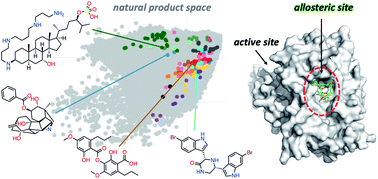Natural allosteric modulators and their biological targets: molecular signatures and mechanisms†
Abstract
Covering: 2008 to 2018
Over the last decade more than two hundred single natural products were confirmed as natural allosteric modulators (alloNPs) of proteins. The compounds are presented and discussed with the support of a chemical space, constructed using a principal component analysis (PCA) of molecular descriptors from chemical compounds of distinct databases. This analysis showed that alloNPs are dispersed throughout the majority of the chemical space defined by natural products in general. Moreover, a cluster of alloNPs was shown to occupy a region almost devoid of allosteric modulators retrieved from a dataset composed mainly of synthetic compounds, further highlighting the importance to explore the entire natural chemical space for probing allosteric mechanisms. The protein targets which alloNPs bind to comprised 81 different proteins, which were classified into 5 major groups, with enzymes, in particular hydrolases, being the main representative group. The review also brings a critical interpretation on the mechanisms by which alloNPs display their molecular action on proteins. In the latter analysis, alloNPs were classified according to their final effect on the target protein, resulting in 3 major categories: (i) local alteration of the orthosteric site; (ii) global alteration in protein dynamics that change function; and (iii) oligomer stabilisation or protein complex destabilisation via protein–protein interaction in sites distant from the orthosteric site. G-protein coupled receptors (GPCRs), which use a combination of the three types of allosteric regulation found, were also probed by natural products. In summary, the natural allosteric modulators reviewed herein emphasise their importance for exploring alternative chemotherapeutic strategies, potentially pushing the boundaries of the druggable space of pharmacologically relevant drug targets.



 Please wait while we load your content...
Please wait while we load your content...